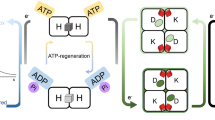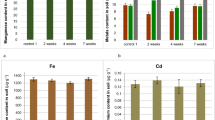Abstract
TRIPHENYLTETRAZOLIUM chloride has been used recently for indicating enzymatic reducing systems in several tissues1–5 under aerobic as well as anaerobic conditions, and many other similar applications have been reviewed by Smith6. We have found that sections of petioles or stems of tomato, cauliflower, swede, kale, clover and other plants are characteristically stained by reduction of solutions of triphenyltetrazolium chloride to the insoluble red formozan pigment. Staining is intense in phloem and strong in cambium and vascular parenchyma, and often in endodermis. It is weak in cortex and epidermis, and negligible or absent in xylem and semi-lignified tissues, for example, pericycle. In leaves the mesophyll stains less than the phloem and vascular parenchyma. Our results confirm closely those of Gall7 (with bean stems) and others6 unknown to us until this work was well advanced.
This is a preview of subscription content, access via your institution
Access options
Subscribe to this journal
Receive 51 print issues and online access
$199.00 per year
only $3.90 per issue
Buy this article
- Purchase on Springer Link
- Instant access to full article PDF
Prices may be subject to local taxes which are calculated during checkout
Similar content being viewed by others
References
Kun, E., and Abood, L. G. G., Science, 109, 144 (1949).
Fred, R. B., and Knight, S. G., Science, 109, 169 (1949).
Black, M. M., and Kleiner, I. S., Science, 110, 660 (1949).
Gunz, F. W., Nature, 163, 98 (1949).
Brodie, A. F., and Gots, J. S., Science, 144, 40 (1951).
Smith, F. E., Science, 113, 751 (1951).
Gall, H. J. F., Bot. Gaz., 110, 319 (1948).
Faubridge, R. A., Willis, K. J., and Booth, R. G., Biochem. J., 49, 223 (1951).
Roberts, L. W., Science, 113, 692 (1951).
Hewitt, E. J., Agarwala, S. C., and Jones, E. W., Nature, 166, 1119 (1950).
Evans, H. J., Purvis, E. R., and Bear, F. E., Plant Physiol., 25, 555 (1950).
Hewitt, E. J., and Hallas, D. G., Plant and Soil, 3, 1 (1951).
Hewitt, E. J., “Ann. Rev. Plant Physiol.”, 2, 25 (1951).
Agarwala, S. C. (unpublished work).
Author information
Authors and Affiliations
Rights and permissions
About this article
Cite this article
HEWITT, E., AGARWALA, S. Reduction of Triphenyltetrazolium Chloride by Plant Tissues and its Relation to Molybdenum Status. Nature 169, 545–546 (1952). https://doi.org/10.1038/169545a0
Issue Date:
DOI: https://doi.org/10.1038/169545a0
This article is cited by
-
The influence of molybdenum on iron nutrition of tomato
Plant and Soil (1967)
-
Le molybdène en biologie
Experientia (1965)
-
Molybdenum in relation to growth of higher plants and micro-organisms
Plant and Soil (1954)
Comments
By submitting a comment you agree to abide by our Terms and Community Guidelines. If you find something abusive or that does not comply with our terms or guidelines please flag it as inappropriate.



